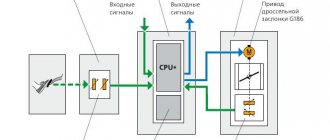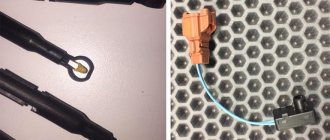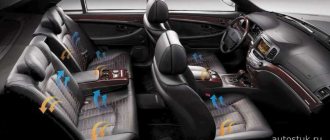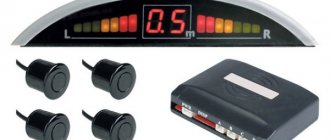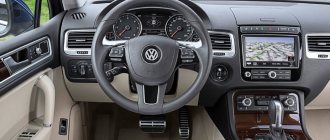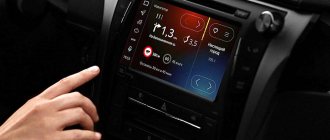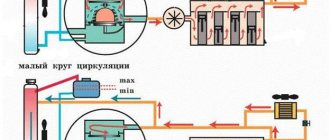Maintaining an optimal microclimate in the cabin has become a mandatory option in every car. This is done by air conditioning, which has recently become a mandatory element and is included in the basic package of all models. Previously, this was an additional option for which you had to pay extra when buying a car. Now this is the climate control system, which is characterized by the number of zones in which a given microclimate must be maintained. But what is the difference between simply air conditioning and climate control, are there any distinctive features at all?
Humidity reduction function
Almost everyone knows that an air conditioner, while working to cool, dries the air. Not many people have heard how climate control in a car copes with this task in winter. To ensure this function, the installation is equipped with a special humidity meter. Data from this sensor is sent to the controller. At low negative temperatures, air dehumidification is usually not required; the stove can handle moisture vapor. The situation changes at temperatures close to zero, in conditions of wet snow, and during a thaw. The car windows begin to fog up intensely. In this situation, your climate control system will operate as follows:
- the humidity sensor will inform the controller about the need to remove excess moisture;
- the controller will give a command to turn on the air conditioner and stove simultaneously;
- moist air passing through the air conditioner evaporator will leave moisture particles in the form of condensation or frost on the heat exchanger honeycombs;
- After the evaporator, the air enters the stove radiator, where it is also further dried.
Thus, the use of climate control prevents the windows from fogging up and provides comfortable driving conditions in winter.
Cabin filter
Before using climate control in your car in winter, carefully read the car's operating instructions. In it you will probably find recommendations for replacing the cabin filter. This air purification element plays a very important role for the operation of the air conditioning system. If the filter is clogged with dust, then heating and drying will be ineffective - the windows will fog up, and the interior will heat up more slowly. Manufacturers offer three options for filter elements:
- paper - the easiest and cheapest cleaning method;
- coal - act much more efficiently;
- antibacterial - prevent the proliferation of pathogenic organisms in the air ducts of the car's air conditioning system.
It is recommended to replace the cabin filter twice a year. In some cases, the procedure will have to be performed more often - for example, when driving on dirt roads.
Does the air conditioner work in winter?
Yes, if outside is above +3..+5°С. At a lower temperature, the refrigerant does not go into a gaseous state, the compressor does not turn on, no matter what is displayed on the screen of the climate control unit. Our winters are such that +5..+7°C in January is not such an impossible phenomenon. As a matter of fact, right now, at above-zero temperatures, the air conditioner will work. And it will also be launched in a warm parking lot of a shopping center, which is definitely a good advantage (there, by the way, the windows tend to fog up). So take advantage of the moment!
Auto mode
When the climate system is turned on, by default it starts operating in automatic mode, which involves distributing the air flow in such a way as to ensure that the temperature is maintained at a given level, separately for the left and right sides of the cabin. If while driving the car the operating parameters of the climate system were set that differed from the original ones, you can return to them by pressing the “AUTO” button (the yellow LED built into the button will light up). The desired zone temperature is set using the corresponding rotary controls. The manufacturer recommends maintaining a value of 22° C (72° Fahrenheit) - this temperature is considered the most comfortable for everyone present in the car.
This indicator is changed if for some reason this temperature does not suit the driver or passengers. It should be noted that climate control allows you to set the temperature within 16 - 29.5 degrees Celsius (61 - 86 degrees Fahrenheit), and these values are conditional - depending on external factors, they may shift slightly to one or another side.
Automatic maintenance of a given microclimate is carried out by controlling the rate of air flow into the cabin, distributing warm and cold air to obtain a given temperature, and also by regulating the direction of airflow. Climate control is able to interpret the amount of solar radiation, accordingly changing the operating parameters of the climate system. This is facilitated by installing a solar radiation sensor. The automatic mode is turned off by pressing any of the control buttons, including the “ECON” button. But this does not mean that the climate control ceases to maintain the specified operating parameters - it is simply considered that new values have been set that will remain the same when the ignition is turned off after the car is stopped.
Codes and common errors
Different manufacturers may use their own codes. Therefore, when digital values appear on the display after self-diagnosis, you need to check your instruction manual.
Some people have identical codes, so on cars from different automakers, one digit will mean an identical malfunction. To ensure that the values correspond to errors, you can rely on the official guidelines.
Most often, when self-diagnosis of climate control equipment, drivers encounter the following problems:
- short circuit in the electrical circuit;
- malfunctions or complete failure of temperature sensors;
- malfunctions in the heating or cooling system settings;
- electric motor failure;
- malfunction of dampers and fan;
- compressor failure;
- decrease in coolant level;
- Damper drive failure, etc.
Sometimes the result of self-diagnosis may be information about malfunctions of the sunlight or air temperature sensor. This is not always true.
This happens if the temperature inside the car is too low because you work in cold conditions in winter, or the car is locked in a garage and the lighting used is insufficient.
Climate systems on cars operate on the same principle. But their design and software are different. This makes it somewhat difficult to find a universal instruction in the absence of an official operating manual specifically for your car.
If you have never carried out self-diagnosis of climate control on a car and do not have sufficient experience to carry out such work, it is better to contact a specialized car service center. Our technicians have the necessary skills and equipment that allow them to quickly check the system’s functionality, detect faults and offer solutions.
It is not necessary to trust the repair itself to specialists. If you wish and have the opportunity, you can fix the damage yourself. The same sensor replacement does not cause problems and is carried out in a few minutes. But serious breakdowns should be entrusted to qualified craftsmen.
Climate control is a useful and effective device for any car. If desired, the system can be installed on machines where it was not originally provided. It provides a high level of comfort in the cabin, but minimizes the need to regulate the operating modes of the equipment, unlike a conventional air conditioner.
Subscribe, leave comments and share your own experience in self-diagnosis procedures. Don't forget to tell your friends about us!
Advantages and disadvantages
Before finalizing the purchase of a car option, you need to familiarize yourself with all the pros and cons.
Advantages
automatic stabilization of the climate inside the car, which is possible thanks to the complex design and a large number of sensors;
the ability to flexibly configure many parameters and ensure the most comfortable environment, which is especially important for multi-zone devices;
fuel economy, since the mechanism operates only during periods of deviation from the norm, and a person does not need to monitor the operation of the equipment;
rapid stabilization of heating in the cabin after opening windows or doors thanks to sensitive sensors.
Flaws
high cost of equipment for installing and maintaining the system.
It is almost impossible to carry out independent repairs or restoration work due to the complexity of the design.
Despite the large number of advantages, climate control has significant disadvantages. Initially, the option of self-repair was used exclusively on expensive cars, after which manufacturers began to develop mass solutions for restoration. The more demand grows, the lower the cost of equipment and the higher the functionality.
With climate control, drivers can forget about having to manually adjust the temperature as everything is done automatically.
general information
Climate control is a modern technological system that provides the highest possible comfort for the driver and passengers. The main task of this equipment is to maintain the most comfortable air temperature in the cabin throughout the entire trip.
Operating principle
The main principle of operation is to maintain optimal temperature conditions using air conditioning and heating systems. To obtain information about the temperature in the cabin, there are sensors capable of transmitting the necessary information to the control unit.
Next, a signal goes from the control unit to certain actuators, such as a temperature damper. The entire process of adjusting and retrieving information from sensors is performed fully automatically.
Main components of the system
The above system consists of the following elements:
Control block. It is the “brain” center of this system and processes incoming signals and sends commands to the main devices. Sensors They are located inside the cabin and monitor the state of the main climate parameters in the cabin. Most car models are equipped with the following sensors: temperature, solar, and vehicle status. Executive devices. Carry out the task coming from the control unit. For example, to increase the volume of air flow, a signal is sent to the electric sensor of the fan. Damper. Used for the normal functioning of the entire system
The damper is a very important part that regulates the distribution of warm and cold air flow inside the car. There are several types of dampers: • central, used for basic air temperature control; • recirculating, which function to regulate the intensity of air flow; • for supplying air from the environment; • for blowing glass.
A little history
The car that started the history of climate control was called the Packard 12 Sedan and was introduced in 1939 . Before this, there were no cars with this option, but car enthusiasts liked the new product, so since the 1940s it was added to some Chrysler and Cadillac models.
Another example appeared in 1968 - the AMC Ambassador, in which a similar system became standard equipment installed by default on all models. It was 1968 that marked the beginning of the popularity of such devices: since then they have appeared in most American cars, already dominating American transport by 54% 1969
America became the first country in which air conditioning mechanisms began to be placed en masse in vehicles. But this trend came late to Europe - these machines appeared extensively there only in the 1980s . Before this, climate control was present only on the richest trim levels, so it was rare.
In 1954, the Nash Ambassador featured the world's first integrated heating, ventilation and air conditioning system.
The company lasted from the late 19th century to the mid- 20th century before giving way to the Studebaker-Packard Corporation. However, the activity of this company did not last long - only a few years.
Climate control and air conditioning - differences
An attentive reader may ask: why complicate the system so much? It is quite possible to get by with a stove for trips in cold weather, but in the summer you will be limited to air conditioning.
This was the case before: each of these systems is capable of providing a comfortable microclimate in the cabin, but only if the internal and external conditions in the car remain unchanged.
But for a moving object, such as a car, this is in principle impossible. The outside air temperature and pressure change with the speed and direction of the vehicle.
The engine is cold when starting and gradually warms up; the air conditioner needs time to reach operating mode. All these factors, in the absence of automation, are monitored by humans and adjusted manually.
The main difference between climate control and air conditioning is the presence of a control system. It monitors temperature and humidity parameters and regulates them without the participation of the driver and passengers.
In such an installation, the air conditioner is one of the components that performs the functions of cooling and reducing humidity. This flow is mixed with the heated one and at the output we get indicators that are comfortable for humans, which are maintained within specified limits automatically.
Car climate system
Let us immediately note that car air conditioning appeared on cars much earlier than the climate. The solution is time-tested, relatively simple and reliable. The main function of an air conditioner is to cool the air. The air is heated by the stove in the car. In turn, climate control allows you to create and automatically maintain a microclimate in the cabin, while requiring minimal participation from the driver.
To make it clearer, a car's air conditioner is actually an air cooling unit. The design includes pipes, a compressor, an evaporator, etc. Simply put, freon (refrigerant) is pumped into a sealed air conditioning system, which circulates through the pipes and radiators thanks to the operation of the compressor. In turn, the outside air is pumped by a fan, contacts the radiator (evaporator), inside of which freon circulates, and is cooled.
The air conditioner, or rather the compressor, only works when the engine is running. The fact is that the air conditioning compressor in a car is driven by the internal combustion engine. Usually the driver turns the air conditioning on and off himself. To adjust the flow temperature (for example, so that the air conditioner does not blow too cold air), you have to mix cold air from the air conditioner and warm air from the heater radiator. This is done by mechanical regulators. However, precise temperature control cannot be achieved.
Now let's look at what climate control is. Structurally, it is still the same air conditioner with a compressor, pipes, etc. However, climate control is equipped with a large number of sensors and an electronic climate control system (climate unit). In fact, the climate system allows you to accurately set the required temperature down to a degree, after which the set air temperature is automatically maintained.
Otherwise, climate control is an automatic climate system (air conditioning and stove at the same time), equipped with a group of sensors to control temperature, humidity, etc. The electronic unit analyzes the sensor information and activates the air conditioning compressor or heater, moves the air duct dampers, distributes the flow of warm and cold air throughout the cabin, etc.
Having considered climate control, what it is and how it works, you can understand that the driver has the ability to quickly set a comfortable mode. In fact, climate control comes down to setting the temperature in the cabin. Moreover, developed systems even make it possible to create a separate climate (for example, dual-zone climate control), when the temperature of the blown air from the deflectors closer to the driver is one, while from the deflectors in the passenger area it is different.
As you can see, climate control and air conditioning are structurally similar in a number of elements, but the systems are completely different. Of course, a climate system based on climate control provides a higher level of comfort, it is simpler and more convenient; controlling climate control actually requires only choosing a comfortable temperature and airflow zone. The climate can be considered especially comfortable if we are not talking about a simple single-zone climate.
Principle of operation
The introduction of this system made it possible to coordinate the operation of heating and air conditioning units and subordinate them to the control center. Also, heating limitation is implemented by internal and external sensors. Based on its readings, the controller regulates the intensity of cooling or heating .
In winter, the device operates as follows:
- The air flow enters the air duct and heat exchanger , the evaporator of the air conditioner. In contact with the cold fins of the radiator, condensation forms.
- A system of dampers equipped with electric drives directs part to the heater radiator for heating.
- At the outlet of the heat exchanger, hot air is mixed with cold air to achieve the set temperature. The proportions are regulated by a controller , which receives a signal from the corresponding sensor.
- The mixed flow enters the cabin, exiting through the deflectors in the front panel or through the passenger footwell.
During the automatic control process, the electronic control unit also relies on the readings of an external temperature sensor. If it's cold outside, the controller will direct air to the heater; in hot weather it will simply go through the cooler.
In summer, the processing of the air mass by the air conditioning system is simplified: there is no need to heat the air in the heater and mix it. The control unit deals only with air conditioning: after cooling to the required value, it stops the compressor. The installation is turned on by a signal from the cabin sensor , which reports heating by 3-5 °C.
In winter, inexpensive versions of the systems can deliver a barely warm stream directly to passengers when the engine has not yet warmed up. Therefore, at this stage the driver has to intervene in the operation of the air conditioner and regulate the heat exchange manually . The difference between the cheapest and most expensive units is that the latter do not blow on the face or legs until it warms up. During the first minutes of operation of the damper motor, air enters the windows.
If the controller sets the desired parameters (the range of 22–24 °C is considered comfortable) and activates the “Auto” mode, then it itself determines the heating (or cooling) intensity, direction and power of the flows. In most cars, the heating level is adjustable between 14 and 28 °C.
Prevention and proper operation
An air conditioner or heater operating as part of climate control must be maintained in optimal technical condition.
Drivers make basic mistakes when operating the system and do not really understand how climate control works in a car.
There are several recommendations that will help avoid unwanted breakdowns and costly repairs to the CC:
- check the system for leaks at least once a year, since the refrigerant used can leak through cracked pipes, loose fasteners and other damaged areas;
- monitor the coolant level and refill as it decreases (this is cheaper than completely refilling the system);
- For repairs and maintenance, contact only specialized service centers, since it is not recommended to repair such equipment yourself;
- in parallel with refueling, diagnose the operation of the electronic unit;
- It is recommended to turn on the system at least 1 minute after starting the engine and turn it off at least 1 minute before stopping the engine;
- to avoid health problems, set the temperature inside the cabin to no lower than 10 degrees compared to the outside temperature (if it is 30 degrees Celsius outside, it is recommended to turn on the air conditioning no colder than 20 degrees);
- Change the cabin filter periodically, especially if you regularly use cooling and heating;
- clean the radiator (air conditioner) to get rid of accumulated dust, turning on the blowing mode once a month for 5 - 10 minutes;
- Clean the interior ventilation using available methods to get rid of contaminants and accumulated harmful microorganisms.
Simple measures that will help extend the life of your climate control equipment. If you do not follow these recommendations, you will regularly encounter problems and costly repairs.
Fault prevention
Any breakdown can be prevented or delayed by following operating instructions. To enjoy a comfortable ride for as long as possible, you must adhere to the following recommendations:
- check the system for leaks annually to avoid refrigerant leakage;
- periodically change the cabin filter;
- clean the radiator of dust monthly;
- refill the refrigerant in a timely manner;
- check the operation of the electronic unit;
- periodically clean the interior ventilation;
- turn the system on and off a minute before starting and stopping the engine.
It is advisable to trust car repairs and maintenance to specialists.
How to use climate control correctly?
General sequence of control of the climate control system:
- Turn on the unit using a separate button or fan speed control.
- Set the required temperature. Most systems allow you to set the temperature in 0.5 ºC increments. The permissible difference between the zones is, at best, 4-5 ºС.
- In manual mode, force the air conditioner to turn on and set the fan speed.
- To turn on the automation, you need to click on the “Auto” button. The unit will further regulate the intensity of the air flow and distribute it throughout the cabin.
- If the owner uses the air conditioning unit little, then it is recommended to turn on the air conditioner on a preventive basis once a month for 10-15 minutes.
Below is a sample dual-zone climate control control unit with a description of the functions of the buttons and switches:
- 1 — air conditioning compressor control key;
- 2 — step regulator of the driver’s system;
- 3 — handle for changing the temperature of the air supplied to the driver’s seat;
- 4 — automatic operating mode;
- 5 — at the top there is a button for supplying the flow to the chest level, below — to the head area, even lower — to the feet;
- 6 — increase in the number of revolutions of the fan impeller;
- 7 — handle for changing the temperature of the air supplied to the passenger seat;
- 8 — step regulator for the passenger seat heating system;
- 9 — maximum windshield airflow;
- 10 — heated rear window;
- 11 — reduction in the speed of the fan impeller;
- 12 — air recirculation in manual or automatic mode;
- 13 — control of electric steering wheel heating.
Purpose of climate control buttons
The control unit may have additional buttons and displays:
- indication of air temperature in the driver and passenger area;
- turning on electric;
- air supply from an autonomous heater.
Features of climate control operation in summer
Summer operation of the device has a number of features:
- It is not recommended to set the climate control temperature below 10 ºС outside environment. This is associated with the risk of colds due to hypothermia.
- It is recommended to ventilate the interior before starting the air conditioning system. This lowers the air temperature and speeds up cooling.
- To speed up the cooling process, air recirculation mode is used.
- It is not recommended to open the windows after the interior has cooled down, since the sensors record the temperature change and load the compressor.
Features of climate control operation in winter
Features of using the system in winter:
- due to the possibility of ice and condensation forming on the dampers, it is not recommended to change air flows until the cabin is warmed up;
- periodically turn on the air conditioning compressor to prevent rubber seals on the refrigerant lines.
Is it possible to install an additional climate system?
The climate control system can be installed under two conditions:
- the car is equipped with air conditioning;
- The design of the car allows for climate control.
To make changes to the design, you will need to install an electronically controlled climate control unit, as well as change the wiring and mount the control panel. Below is an example of self-installation of climate control on a Polo Sedan.
A number of cars, for example, the first generation Hyundai i30, can be equipped with climate control by replacing the control unit, temperature sensors, fan resistance and installing a solar radiation sensor along with a modified wiring harness.
What you will need
Set of replacement components:
- Heater equipped with electric damper actuators and sensors. Polo Sedan cars are similar to a part of a similar purpose from Skoda Rapid. The difference will be in some of the wiring plugs and in the glove box cooling system hose.
- Heater wiring harness. Replacing the unit is mandatory, since the wires are used to connect the heater with the control unit.
- Directly the control unit and a decorative frame for it.
- Wiring for connecting the control unit with the on-board digital bus and sensors.
- Coolant.
- Cold air supply valve to the glove box.
- Since replacing the heater involves dismantling the pipes, the air conditioner will need to be refilled with refrigerant.
Algorithm of actions
Sequence of replacement steps:
- Drain the antifreeze and coolant.
- Disconnect the lines from the standard heater.
- Remove the instrument panel assembly with the heater.
- Remove the old heater and install a new one in its place.
- Install the solar radiation activity sensor in its original place.
- Connect the new heater to the standard wires using a modified braid.
- Reinstall the instrument panel.
- Reprogram the electrical unit to use climate control. If you skip this operation, the system will not work correctly.
- Refill cooling and climate control systems.
Photo gallery
The photographs show the steps to install climate control on a Polo Sedan.
Interior with dismantled instrument panel
New heater
Wiring braid
The device is registered in the electronics unit
Climate control programming
Assembled instrument panel with climate control unit
Filter
Before using climate control in your car in winter, carefully read the car's operating instructions. In it you will probably find recommendations for replacing the cabin filter. This air purification element plays a very important role for the operation of the air conditioning system. If the filter is clogged with dust, then heating and drying will be ineffective - the windows will fog up, and the interior will heat up more slowly. Manufacturers offer three options for filter elements:
- paper - the easiest and cheapest cleaning method;
- coal - act much more efficiently;
- antibacterial - prevent the proliferation of pathogenic organisms in the air ducts of the car's air conditioning system.
It is recommended to replace the cabin filter twice a year. In some cases, the procedure will have to be performed more often - for example, when driving on dirt roads.
https://promotornoemaslo.ru/avto-vopros-otvet/kak-pravilno-polzovatsya-klimat-kontrolem-v-avtomobile/https://remam.ru/vozdsys/kak-rabotaet-klimat-kontrol-zimoj.htmlhttps: //topdetal.ru/stati/kak_pravilno_polzovatsya_klimat_kontrolem_v_avtomobile_zimoy/https://www.zr.ru/content/articles/904724-mozhno-li-ispolzovat-konditsio/https://okuzove.ru/poleznye-stati/kak-rabotaet- klimat-kontrol-v-avtomobile-zimoj.html
Summarizing
Using all the information presented above, even a novice motorist can easily determine how to properly use climate control in a car. This system can create comfort inside the cabin during vehicle operation.
Good to know: Is it possible to wash a car engine at a car wash?
But to work effectively, you should know how to properly use climate control in a car in the summer. In addition, you need to navigate the features of operating this system in winter. Therefore, it is necessary to clearly know how to use climate control in a car in winter.
Functional features of the system
The number of possible climate control functions depends on the car model, its type and the sensors used. The list of features includes:
- maintaining the desired temperature by cooling the interior in the summer and heating in the winter;
- taking into account the ambient temperature using signals from a solar radiation analysis sensor, which determines the impact of ultraviolet radiation, as well as an outboard temperature sensor;
- recirculation and purification of air in the car interior, thanks to the presence of special filters;
- sophisticated temperature control in various areas of the cabin, including the driver's seat, passengers, rear seats and much more;
- prevention of glass fogging in the cabin in winter thanks to high-quality and uniform heating.
Air flow movement
A large number of drivers prefer climate control instead of air conditioning. Both solutions are designed for the sole purpose of maintaining a comfortable temperature in the cabin. But the air conditioner must be adjusted manually, and the climate system automatically adjusts the operating parameters.
What are the Econ and Sync buttons?
Some car devices contain Econ and Sync buttons. There are many myths among motorists about its purpose. Peculiarities:
- Econ is an economical mode that forcibly regulates or stops the compressor at the touch of a button. In some models, the air conditioner continues to operate, but the engine speed does not increase, which saves fuel.
- Synchronization is a special option for thermoregulation in different areas of the cabin. It is used exclusively in air conditioning systems consisting of two or more zones.
Features of operation in winter
The climate control algorithm described above is quite general. Each manufacturer develops a climate system for a specific model or series. The controller software may also differ slightly. The latest versions of electronic climate control allow the car owner to independently program some of the installation functions. The operation of climate control in a car in winter sometimes requires intervention and switching to manual control:
The car was in an open parking lot and its windows were covered with ice. To start moving, you need to quickly clear the viewing areas from ice. Not all climate control firmwares provide for automatic pre-heating of the windows. There may be a situation where the program provides such a function, but the specified heating time was not enough. In this case, you have to exit the automatic mode and manually turn on the glass defrost. You will also have to choose the fan speed. Once the icing is cleared, you can return to automatic settings.
- Often, unlucky drivers rely on the warmth inside the car and neglect reliable winter shoes. Inopportunely fallen snow forces us to trample around the car for a while. After freeing the car from a snowdrift, the driver receives wet feet as a bonus. In such a situation, the most correct solution is to switch to manual control and direct the flow of hot air to the legs.
- You can spend quite a lot of time in long winter traffic jams caused by ice and snow. In order to avoid exhaust gases from vehicles accumulated around getting into the car interior, use the “Recirculation” mode. Only very advanced climate control systems are equipped with an automatic CO level analyzer in the external air intake.
